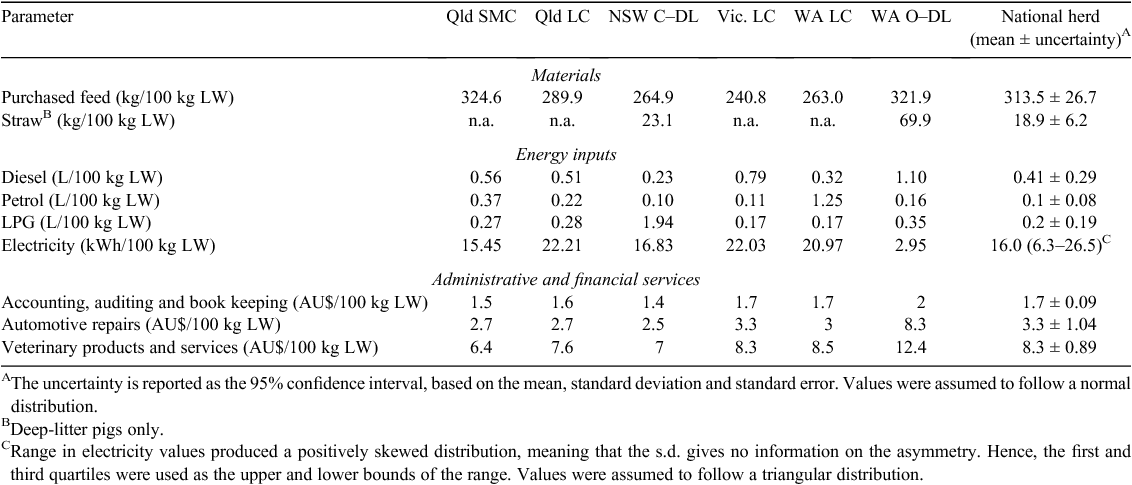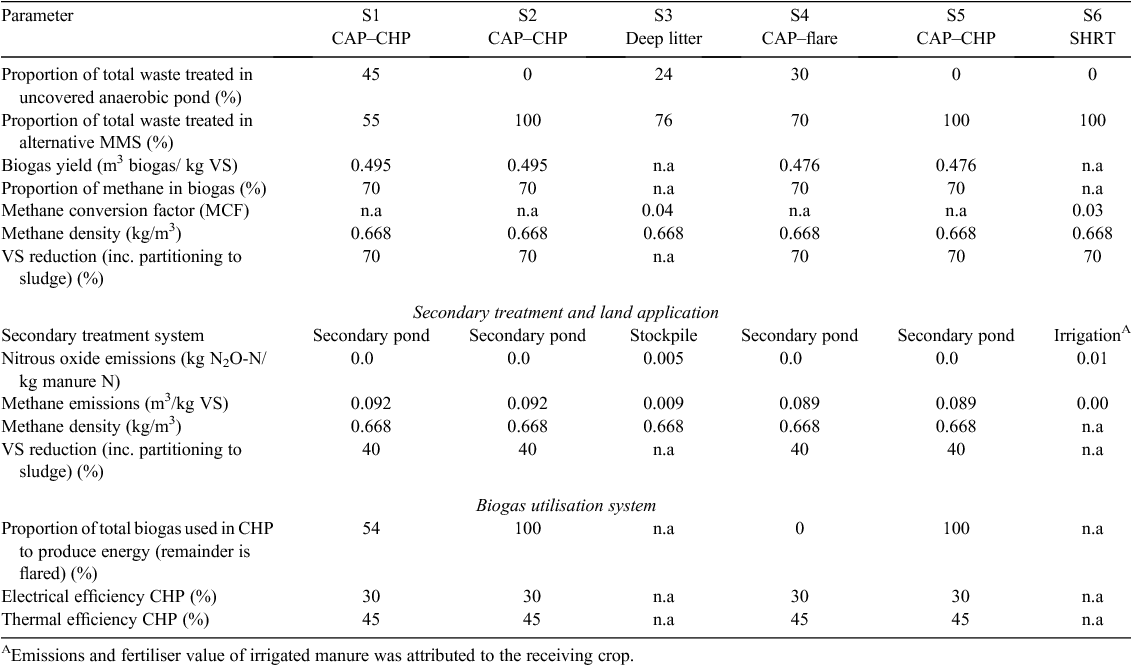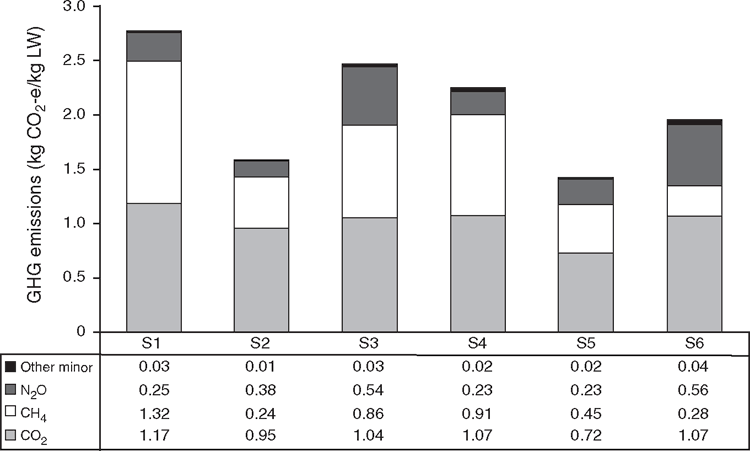Environmental impacts and resource use from Australian pork production assessed using life-cycle assessment. 1. Greenhouse gas emissions
S. G. Wiedemann A B , Eugene J. McGahan A and Caoilinn M. Murphy AA FSA Consulting, PO Box 2175, Toowoomba, Qld 4350, Australia.
B Corresponding author. Email: stephen.g.wiedemann@gmail.com
Animal Production Science 56(9) 1418-1431 https://doi.org/10.1071/AN15881
Submitted: 18 December 2015 Accepted: 7 March 2016 Published: 12 May 2016
Journal Compilation © CSIRO Publishing 2016 Open Access CC BY-NC-ND
Abstract
Agricultural industries are under increasing pressure to measure and reduce greenhouse gas emissions from the supply chain. The Australian pork industry has established proactive goals to improve greenhouse-gas (GHG) performance across the industry, but while productivity indicators are benchmarked by industry, similar data have not previously been collected to determine supply chain GHG emissions. To assess total GHG emissions from Australian pork production, the present study conducted a life-cycle assessment of six case study supply chains and the national herd for the year 2010. The study aimed to determine total GHG emissions and hotspots, and to determine the mitigation potential from alternative manure treatment systems. Two functional units were used: 1 kg of pork liveweight (LW) at the farm gate, and 1 kg of wholesale pork (chilled, bone-in) ready for packaging and distribution. Mean GHG emissions from the case study supply chains ranged from 2.1 to 4.5 kg CO2-e/kg LW (excluding land-use (LU) and direct land use-change (dLUC) emissions). Emissions were lowest from the piggeries that housed grower-finisher pigs on deep litter and highest from pigs housed in conventional systems with uncovered anaerobic effluent ponds. Mean contribution from methane from effluent treatment was 64% of total GHG at the conventional piggeries. Nitrous oxide arose from both grain production and manure management, comprising 7–33% of the total emissions. The GHG emissions for the national herd were 3.6 kg CO2-e/kg LW, with the largest determining factor on total emissions being the relative proportion of pigs managed with high or low emission manure management systems. Emissions from LU and dLUC sources ranged from 0.08 to 0.7 kg CO2-e/kg LW for the case study farms, with differences associated with the inclusion rate of imported soybean meal in the ration and feed-conversion ratio. GHG intensity (excluding LU, dLUC) from the national herd was 6.36 ± 1.03 kg CO2-e/kg wholesale pork, with the emission profile dominated by methane from manure management (50%), followed by feed production (27%) and then meat processing (8%). Inclusion of LU and dLUC emissions had a minor effect on the emission profile. Scenarios testing showed that biogas capture from anaerobic digestion with combined heat and power generation resulted in a 31–64% reduction in GHG emissions. Finishing pigs on deep litter as preferred to conventional housing resulted in 38% lower GHG emissions than conventional finishing.
Additional keywords: agricultural systems, global climate change, manure, methane, nitrous oxide.
Introduction
In Australia and globally, there is increased interest from industries, governments and consumers regarding the environmental performance of agri-food production systems. Of these impacts, greenhouse-gas (GHG) emissions are of particular concern to governments and the general public. The Australian pork industry has established proactive goals to reduce GHG emission intensity of pork production. However, while productivity and business indicators are numerous and regularly measured, GHG emissions have not previously been benchmarked by the industry. Comprehensive assessment methods such as life-cycle assessment (LCA) include emissions throughout the production system and also emissions associated with input commodities such as feed. Such tools are effective in comparing different management systems because impacts from the whole system are taken into account. Impacts are generally reported relative to production (i.e. per kilogram of product) and, therefore, take into account the positive effect that changes in system efficiency may have on environmental indicators such as GHG emissions. LCA has been applied to determine supply chain GHG emissions at the regional or national scale for milk and dairy products (Gollnow et al. 2014), beef (Wiedemann et al. 2015a, 2016a), export lamb (Wiedemann et al. 2015b, 2016b) and chicken meat (Wiedemann et al. 2012b). The present study provides the first case study and national analysis of GHG emissions from Australian pork production using LCA. The study aimed to benchmark GHG emissions throughout the primary-production supply chain, determine emission hotspots and investigate the mitigation potential of several alternative manure-management systems.
Materials and methods
Goal and scope
The study was an attributional investigation of pork production from major production regions and different production systems in Australia, to provide information to the pork industry, research community and the general public.
The study investigated GHG emissions using the Intergovernmental Panel on Climate Change (IPCC) AR4 global warming potentials of 25 for CH4 and 298 for N2O (Solomon et al. 2007) as applied in the Australian National Inventory Report (NIR; Commonwealth of Australia 2015a). GHG emissions associated with land use (LU) and direct land-use change (dLUC) were included and reported separately, following guidance from the Livestock Environmental Assessment and Performance partnership (LEAP 2014a). The primary production supply chain, including breeding through to finishing (sometimes at multiple sites) and meat processing was included, with all associated inputs. Data were collected and impacts were assessed from a series of case-study farms (CSFs), and a national assessment was performed using national survey statistics, as described in the following sections. The end-point of the supply chain was the cold storage unit where pork is stored before wholesale distribution. Results are presented using two functional units: 1 kg of pork liveweight (LW) at the farm gate, and 1 kg of chilled, bone-in pork cuts ready for distribution to retail. The system boundary of the study is shown in Fig. 1 with the dashed line denoting the foreground system. The red arrow represents the flow of gilts (young females) and boars back into the breeding herd.
Case-study farms
Fourteen farms were surveyed in the following four major production regions of the country: Queensland (Qld), New South Wales (NSW), Western Australia (WA) and Victoria (Vic.). Data were collected from detailed company records via site visits. A minimum of 12-month production data were collected from each farm in the Years 2010–2011 for all farms except the Vic. CSF, where data were collected in 2013. The farms were grouped into supply chains representing either an aggregation of small farms, or a series of farms (breeder, grower, finishers). The supply chains are described by state, piggery size and housing type as follows: Qld small–medium conventional (Qld SMC), Qld large conventional (Qld LC), NSW conventional housing (breeding pigs) and deep-litter housing for grower–finisher pigs (NSW C–DL), Victorian large conventional (Vic. LC), Western Australian large conventional (WA LC) and WA outdoor housing (breeder pigs) and deep-litter housing for grower–finisher pigs (WA O–DL). Each supply chain included multi-site production under the same management, with the exception of the Qld SMC supply chain, which included five independently owned, closed herd farrow-finish piggeries of 100–600 sows. Average performance data for each of the supply chains are presented in Table 1, based on farm records. Herd productivity across the CSF farms was within the range reported for the industry for pigs weaned per sow per year and feed-conversion ratio (FCR), suggesting that these were reasonably representative of industry performance (APL 2012).
National herd
To determine impacts from the Australian national herd, a separate model was developed using national herd statistics for the year 2010. Herd numbers were accessed from the survey of Australian farms (ABS 2012), which included breeder and grower pig numbers by state. An independent dataset of the total number of pigs slaughtered, and total carcass weight (ABS 2014a, 2014b), was available to determine the total output of the herd. The number of pigs produced for slaughter per sow was determined by dividing total slaughter numbers by total sow numbers. From this, litters per sow per year and pigs weaned per sow per year (Table 1) were determined using mortality rates from the CSF dataset. These productivity factors corresponded well to industry statistics (APL 2012), although FCR was slightly higher from our analysis. Breeder mortality and replacement rates in the national herd were determined from data averaged across the CSF dataset. Production was concentrated in the following four regions: NSW–Vic. (combined) (49% of production), Qld (23%), WA (11.4%) and SA (16.6%). The small Tasmanian herd (0.6% of total) was modelled using data from NSW–Vic. in the absence of specific data for this region.
The proportion of pigs across the national herd housed and managed in different housing types influenced energy use and the type of manure-management system (MMS), both being contributing factors to GHG emission intensity. These data were taken from the Australian NIR (Commonwealth of Australia 2015a), which was revised in 2014 on the basis of an industry survey of management practices. Uncertainty for the herd-production data was added to parameters that have the greatest effect on herd efficiency, on the basis of the range observed in the CSF dataset, assuming normal distributions.
Operation inputs
Operation inputs including energy, administration, veterinary and other services were accounted and reported per 100 kg LW sold (Table 2). Energy data were collected from each farm averaged over a minimum 12-month period. Purchased services (e.g. administration, veterinary services, vehicle repairs) were modelled on the basis of expenditure, using economic input–output data (Rebitzer et al. 2002). Capital infrastructure (i.e. buildings) and machinery were excluded on the basis of their minor contribution (<1% of impacts) assessed during the scoping phase. Impacts from packaging of wholesale pork were also excluded. Impacts generated off-farm via the use of purchased inputs were modelled using background data sourced from the Australian life-cycle inventory database (Life Cycle Strategies 2015) where available or the European EcoInvent (3.1) database (Weidema et al. 2015). Where measured inventory data were supplied from the CSFs, uncertainty in the estimates was assumed to be negligible. However, where estimates or calculation methods were used to determine inventory inputs or outputs, uncertainty data were included using triangular distributions, with the mean being the selected value, and the outer bounds being twice the standard deviation. Where the lower bound produced a negative number, this was replaced by zero (see Table 2). Purchased inputs for the national herd were determined from an inventory of 33 piggeries (FSA Consulting, unpubl. data) and the CSF inventory dataset. Uncertainty was determined from the mean, standard deviation and standard error of these datasets (see Table 2).
Transport
Transport data were collected for all transfers of materials within the supply chain. Major transport stages included grain transport (farm-storage, feed-mill, pig farm) and transport of pigs between farms (at multiple site facilities) and to the meat-processing plant. Transport data were calculated as tonne kilometres and were classified according to truck type, using AustLCI transport-unit processes. Staff transport to and from work was calculated from staff records and typical travel distances, and was included in the model (see Table 3).
Feed use, feed production and milling
Feed use at the CSFs was determined from records of feed deliveries over a 12-month period. Several diets were fed at each farm to different classes of pigs, and diets were aggregated for the breeder, weaner and grower–finisher herds to produce three simplified rations (Table 4). Feed intake and feed wastage for the national herd was determined using the PIGBAL model (Skerman et al. 2015), using herd performance data shown in Table 1. Four standard diets were modelled for the main production regions in the national herd, after Skerman et al. (2014). Diet A was considered representative of the NSW–Vic. region and Diet B was used for the Qld region. Diet D was considered representative of the WA region; however, the mung bean diet component was replaced by lupins, which was more representative of data collected by the authors from major WA piggeries (Table 4; S. G. Wiedemann, unpubl. data). Diet D was also considered representative of the SA region; however, the mung bean component was replaced by field peas, which was more representative of data collected by the authors from major piggeries in this region (S. G. Wiedemann, unpubl. data). In addition, the proportions of barley and wheat were modified to include a larger fraction of barley in the SA diet than in the WA diet. Aggregated, simplified rations for the breeder, weaner and grower–finisher units for the CSFs and the national herd are shown in Tables 4 and 5.
Major feed grains were modelled from Australian grain processes available from the AustLCI database (Life Cycle Strategies 2015) and Wiedemann et al. (2010). These processes were updated to include emission factors from the Australian NIR 2013 (Commonwealth of Australia 2015a). For major grains in each region, the proportion of grain produced in different systems (i.e. dry land and irrigated) was determined using the proportion of crop land irrigated in each state (ABS 2009, 2010, 2011). Using these data, grain processes were aggregated to provide an average market for the major grains in each state (see Table S1, available as supplementary material for this paper).
Where data were unavailable for some small dietary inputs such as vitamins, substitutions were made with other feed inputs, using product cost to guide the substitution. Feed-mill energy data were collected from three commercial feed-mills (see Table 6). These data were averaged and used for all CSFs and the national herd, with state-based electricity processes used.

|
Land-use and direct land use-change emissions
Land-use (LU) and dLUC emissions were assessed for Australian- and imported-crop production systems. The area sown annually to crops has expanded in Australia in the period 1990–2010 (Lesslie and Mewett 2013), and Wiedemann et al. (2016b) suggested that the expansion in land cropped was up to 21% in some states. An analysis of data from the Australian national inventory (Commonwealth of Australia 2015b) showed that annualised emissions associated with conversion of forest land to crop land were 4 755 000 t CO2-e in the period 1990–2010 (Commonwealth of Australia 2015c). The analysis of LU emissions from crop land were –4 800 000 t CO2-e (negative emissions indicate carbon sequestration), annualised over the same period. Carbon sequestration in Australian crop land is mostly in response to carbon sequestration resulting from adoption of improved cropping practices over the past 20 years. When divided by the average total land area sown to crops annually in Australia over the period 1990–2010, annualised emissions from LU and dLUC were –229 and 227 kg CO2-e/ha. Differences in LU emissions or sequestration are likely to exist among cropping regions in Australia based on specific management (Wiedemann et al. 2016b). However, in the present study, we accounted LU and dLUC emissions from crop land at the national scale, as suitable disaggregated datasets were not available to assess impacts associated with individual crops or cropping regions.
Imported soybean meal was modelled using data from the EcoInvent database (Swiss Centre for Life Cycle Inventories 2014) based on the relative imports of soybean meal from: Brazil (41%), Argentina (40%) and the USA (19%) (OEC 2015).
Manure management
Pigs were housed in (1) conventional housing systems (breeder, grower and finisher pigs), (2) outdoor housing (breeder pigs) or (3) deep-litter housing (grower and finisher pigs). Conventional housing refers to housing with partially or fully slatted floors where manure, urine, waste feed and water drop into channels or pits that are flushed or released regularly (generally twice per week) into open, anaerobic lagoons. Outdoor housing refers to a system where pigs are allowed to range in an open paddock and are supplied with shelters. Deep litter refers to pigs being housed on litter (e.g. straw, sawdust, rice hulls) for the grower or finisher stage of production. In all the deep litter systems studied, spent litter was cleaned out after each batch of pigs, which is common practice in Australia.
Manure-management emissions were modelled from predicted manure excretion and feed waste using the PIGBAL manure-estimation model (Skerman et al. 2015) for each piggery and for the national herd. Briefly, the PIGBAL model uses a mass-balance approach to predict excreted nitrogen, and the dry-matter digestibility approximation of manure production method to determine excreted volatile solids. Feed waste is a predicted input to the manure stream. Manure emissions were determined using the emission factors outlined in the Australian NIR (Commonwealth of Australia 2015a). Key factors are shown in Table 7, and the mass of manure and waste feed relative to the functional unit is shown in Table 8. Integrated emission factors and manure mass flow data were used for the Australian national herd (Commonwealth of Australia 2015a) and these factors are provided in the supplementary material (Tables S2, S3). Uncertainty associated with emission factors was determined from the corresponding IPCC inventory methods (Dong et al. 2006).
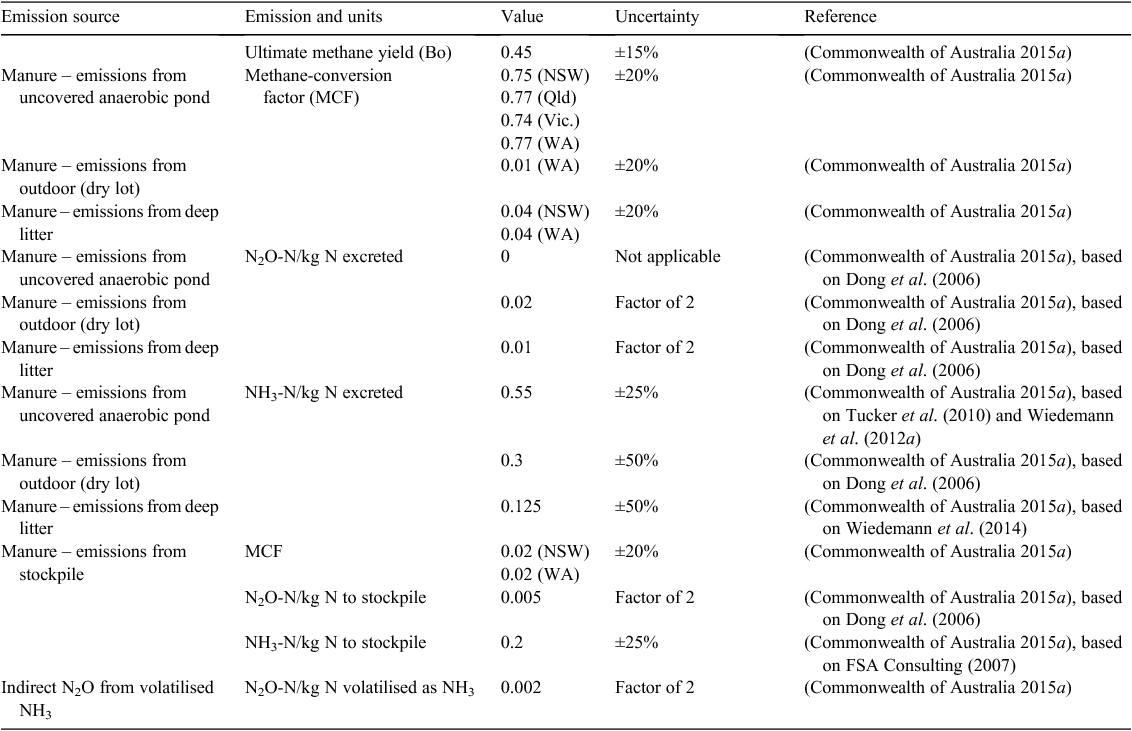
|

|
Meat processing
Meat-processing inventory data were collected from four large pork-processing plants over a 12-month period. Data were averaged and used for all supply chains. Table 9 provides the input data to process 1000 kg of chilled pork.
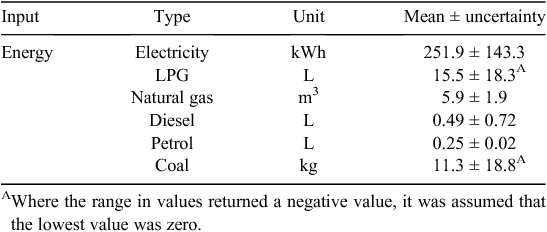
|
Allocation
Allocation processes are required for several points in the feed- and pig-production systems. In the feed-supply chain, economic allocation processes were used to determine impacts to protein meals and oil products (see supplementary material, Table S4). Where rendered products such as meat meal were included in the feed supply chain, only the impacts associated with rendering the product and transporting it were attributed to pig production.
The pig-supply chain delivers multiple products at different points in the system. Product yield and mass flow data were collected from abattoirs and detailed in Wiedemann and Yan (2014). LW from young slaughter pigs and older, culled breeding animals was aggregated to avoid allocation. Similarly in the meat-processing plant, all meat products entering the human supply chain, including edible offal, were aggregated to avoid allocation (Wiedemann and Yan 2014; LEAP 2014b, 2015). Manure and effluent were treated as residues after on-site treatment, as few piggeries generated sufficient revenue from manure or effluent sales to treat this as a co-product. Manure from conventional piggeries is typically land-applied on-site to crops, or pastures grazed by beef cattle or sheep. Solid residues such as sludge and spent litter are more readily transported off-site for application on crop land. Emissions arising from land application of these residues were allocated to the industry that utilised the manure nutrients. To account for the input of manure to crop systems, we assumed that 30% of manure nutrients were returned to the grain-production system, representing 0.6% of cereal crop fertiliser requirements nationally. Manure was included as an input to the modelled cereal crop systems used in the feed inventory.
At the meat-processing plant, pet food was produced as a co-product to meat. Economic value was used to determine the allocation of impacts to each product, with allocation fractions of 99.3% for meat and 0.7% for pet food. Renderable products were considered a residue, and no impacts were allocated to these products. The estimated edible fraction of the retail product was 0.85, based on values reported in Wiedemann and Yan (2014). LW and carcass weight mass flows, relative to 1000 kg of pork, are detailed in the supplementary material (Table S5).
Scenario modelling
The impact of alternative housing and MMSs was investigated using two case-study piggeries. Scenario assumptions are described as follows:
-
Scenario 1 (S1): Qld LC – covered anaerobic pond (CAP) with combined heat and power (CHP) at the grower–finisher unit. The Qld LC piggery installed a CAP with CHP after the benchmarking period (2010–2011) and this scenario was modelled using site data collected in 2014. Under current operational conditions, all effluent from the grower–finisher pigs is treated in a CAP, or 55% of total manure from the piggery. Approximately 54% of the biogas is converted to electrical and heat energy in the CHP engine and the remainder is flared. Following treatment in the CAP, effluent flowed into a secondary pond.
-
Scenario 2 (S2): Qld LC – CAP–CHP at the whole piggery. This scenario modelled the piggery operating at maximum potential for biogas production and energy recovery. It was assumed that all effluent produced at the piggery was treated in CAPs and all biogas produced was converted to electricity and heat in the CHP.
-
Scenario 3 (S3): Qld LC – DL. This scenario modelled a conversion of the animal houses to use deep litter for the grow-out and finishing stages. Manure emission factors for methane are significantly lower for deep-litter housing than for conventional effluent treatment (Commonwealth of Australia 2015a) and emissions per kilogram of pork produced are expected to be lower (Wiedemann et al. 2014). In addition, electricity consumption is lower for the -itter system, as it uses natural ventilation, whereas the Qld LC CSF is tunnel ventilated. A diagram of the CSF and scenario supply chain is provided in Fig. 2.
-
Scenario 4 (S4): Vic. LC – CAP. This piggery also installed a CAP following the benchmarking period, and data were collected to model the impact of this change as a scenario. This supply chain produces pigs on three different sites. The CAP was installed to treat effluent from all finisher pigs, and 56% of the grower pigs. In total, 70% of effluent is treated in the CAP and all biogas is flared.
-
Scenario 5 (S5): Vic. LC – CAP–CHP, all manure treated. This scenario modelled the piggery operating at maximum potential for biogas production, with biogas used to produce electricity and heat.
-
Scenario 6 (S6): Qld SMC – short hydraulic retention time (HRT) effluent storage and irrigation. This scenario modelled the Qld SMC average piggery with short-term storage and rapid irrigation to avoid emission generating anaerobic pond conditions. Modelling was done using assumptions from the Commonwealth of Australia (2015a). Assumptions for each scenario are provided in Table 10.
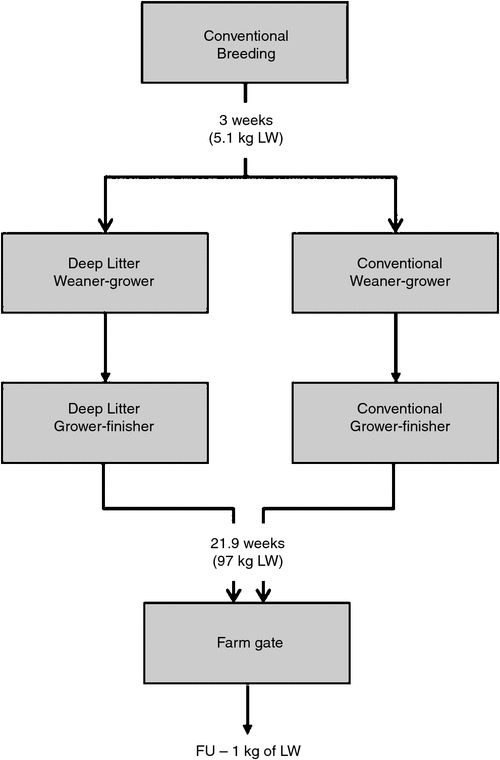
|
Modelling and statistical analyses
Modelling was undertaken using Simapro™ 8.0 (Pre-Consultants, Amersfoort, The Netherlands). Model uncertainty for the national herd was assessed using Monte Carlo analysis in SimaPro 8.0. One-thousand iterations provided a 95% confidence interval for the results. Multiple linear regression analysis was used to describe the influence of key herd parameters and farm variables on GHG emissions.
Results
Farm gate
Total GHG (excluding LU and dLUC) ranged from 2.1 to 4.5 kg CO2-e/kg LW for the NSW C–DL, and Qld SMC respectively (Fig. 3). Emissions from the conventional CSFs (Qld SMC, Qld LC, Vic. LC and WA LC) were higher than for the alternative production systems (NSW C–DL and WA O–DL) in response to the very high emissions (averaging 64% of total GHG) from uncovered effluent treatment at the conventional piggeries. Nitrous oxide arose from both grain production and manure management, with the largest emissions observed from the NSW C–DL (25%) and WA O–DL (33%) piggeries where nitrous oxide emissions from the MMS were highest. Carbon dioxide associated with fossil-fuel use ranged from 23% to 42% of total emissions.
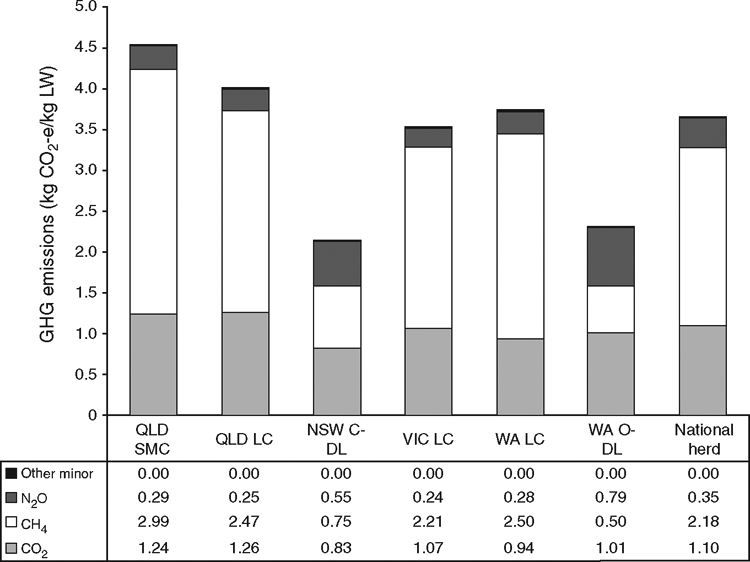
|
Total GHG emissions (excluding LU and dLUC) for the national herd was 3.6 kg CO2-e/kg LW. The predominant factor influencing emissions was the proportion of pigs managed with high or low emission-intensity MMSs. A moderate proportion (35%) of the national herd is managed with deep litter or outdoor housing, or covered ponds. As a consequence, the national average emissions were 8% lower than the conventional CSFs. This difference may have been greater, except for the poorer FCR for the national herd than for the mean of the conventional CSFs.
Emissions from LU and dLUC sources ranged from 0.08 to 0.7 kg CO2-e/kg LW for the WA LC and Vic. LC CSFs respectively. Losses predominantly arose from dLUC in Australia and South America (soymeal production), which was partially offset by carbon sequestration in Australian crop land. As LU and dLUC associated with Australian cropping largely cancelled each other, differences in net LU and dLUC emissions were associated with the rate of inclusion of soymeal in the diet and the FCR.
The linear regression analysis (Fig. 4) showed that the FCR was able to explain 0.88 of the variation (P < 0.001) in GHG intensity (excluding LU and dLUC) at conventional piggeries. The regression model of GHG emission intensity was
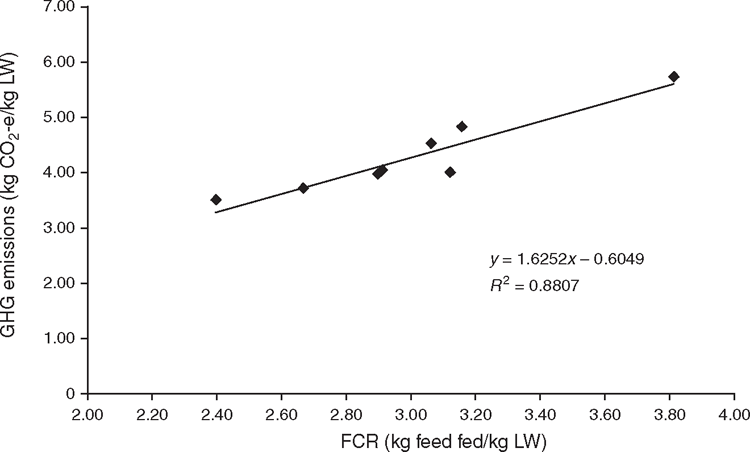
|

Farm gate-scenario analysis
Figure 5 shows the total GHG emissions for LW production for the Qld LC and Vic. LC CSFs (baseline), and the alternative housing and manure-management scenarios. For the Qld LC scenarios, emissions were reduced by 31%, 60% and 38% for the Qld LC – CAP (S1), Qld LC – CAP (S2) and Qld LC – DL (S3) respectively. For the Vic. LC scenarios, emissions were reduced by 44% and 64% for the Vic. LC – CAP (S4) and Vic. LC – CAP (S5) respectively. Emissions from the short HRT system were 57% lower than emissions from the Qld SMC with the current management, suggesting that this approach is also a significant mitigation opportunity.
Lower GHG and fossil fuel energy demand for the CAP–CHP scenario was the result of reduced methane emissions, reduced electricity demand at the piggeries and reduced gas use for heating at the piggeries and, therefore, provided more co-benefits than deep-litter housing or short-HRT systems.
Wholesale pork – national herd
Greenhouse-gas intensity (excluding LU, dLUC) from the national herd was 6.36 ± 1.03 kg CO2-e/kg wholesale pork. The emission profile was dominated by methane from manure management, followed by ration production and then meat processing (Fig. 6). Emissions from LU and dLUC sources were 0.38 ± 0.5 kg CO2-e/kg wholesale pork, with net emissions predominantly arising from dLUC associated with South American soymeal production.

|
Discussion
The current study presents the first comprehensive analysis of GHG emissions from Australian pork production by using LCA. Substantial differences were observed among housing and MMSs, and as a result of production efficiency, but fewer differences were observed among production regions. Conventional housing and open, anaerobic effluent-treatment systems generated high levels of manure emissions, contributing 2.2–3.0 kg CO2-e/kg LW. The Australian National Inventory applies values that are close to the highest methane-conversion factors provided by the IPCC (Dong et al. 2006), because the very high temperatures and long-HRT systems used in Australia lead to high rates of methane production. Recent research (McGahan et al. 2016) has confirmed that emissions arising from these treatment systems are very high by global standards. As a result of the higher emissions from manure management, emissions from conventional pork-production systems in Australia tended to be higher than emissions from northern hemisphere countries (i.e. Pelletier et al. 2010; Reckmann et al. 2012).
We found that deep-litter housing for grower and finisher pigs produced ~30% lower emissions than did conventional housing of grower and finisher pigs (Scenario 3) in response to lower emissions from manure management. Total emissions per kilogram LW for the deep-litter systems were similar to those in other studies (Basset-Mens and van der Werf 2005; Pelletier et al. 2010). Manure excreted in a deep-litter house is managed in a predominantly aerobic environment, leading to low methane emissions. While nitrous oxide emissions are higher from manure managed in deep-litter sheds than from that in conventional sheds, net GHG emissions were considerably lower, suggesting that this housing system offers a mitigation opportunity (Phillips et al. 2016). GHG emissions from outdoor housing were also lower than those from conventional production in the present study. We note that the study relied on default emission factors from manure excreted in outdoor pig-farming areas and this may have increased uncertainty in the result. However, the nitrous oxide factor applied to excreted manure is ~10 times the equivalent Australian factor for nitrous oxide emitted from synthetic fertiliser, and double the factor for land-applied manure emissions. Thus, it is likely to be conservative. While the outdoor CSF had poorer production efficiency (pigs weaned per sow per year and FCR), which resulted in higher feed-related impacts, manure emissions were considerably lower for reasons similar to those in the deep-litter housing. While GHG impacts were lower, other impacts such as eutrophication may be a concern with outdoor pig farming, as a result of off-site nutrient export and leaching of nutrients, and would need to be assessed to provide a more rounded environmental assessment.
The scenario modelling showed large reductions in GHG emissions for conventional housing systems where CAP and CHP or short-HRT systems were installed to replace open effluent ponds. Two scenarios (Scenarios 1 and 4) were based on actual installed systems at the case-study piggeries and, therefore, provided insight into the likely emission reductions under commercial conditions. These piggeries housed breeder, weaner and grower–finisher pigs in different houses at distances of up to 8 km apart. The CAP systems were installed at the grower–finisher sites, where the largest amount of manure is produced. At the Qld LC site, the heat produced by the CHP was not fully utilised, because it was logistically difficult to transport heat from the grower–finisher site to the breeder site, where most heat is required. This is a common problem for multi-site piggeries and may limit the theoretical capability of CHP units to meet the heat requirements of the piggery. We observed that transporting electricity from the generation site to other sites was logistically difficult, requiring, in some instances, the installation of privately owned power networks with high capital costs. We also observed that excess electricity was not easy to sell by exporting to the grid at the Qld LC site, and, at the time of performing the analysis, cost-effective agreements had not been established with local power providers. As a result, excess biogas was flared to destroy the methane, but the energy potential was not utilised.
Where we modelled all manure being treated in CAP–CHP systems (Scenarios 2 and 5), total emissions at the farm level were reduced by 60% and 64%, to 1.6 and 1.4 kg CO2-e/kg LW. When converted to a carcass-weight basis, the lowest impacts for pork are in the order of 2.3 kg CO2-e/kg carcass weight, which is approaching a level of efficiency similar to that for chicken meat produced in Queensland, Australia (Wiedemann et al. 2012b).
As an alternative to CAP–CHP systems, we modelled a simple short-HRT system where anaerobic treatment is avoided through rapid irrigation of effluent to land. This system may be more cost effective at small piggeries, where the high capital cost of installing CAP systems is prohibitive. This also provided substantial reductions in GHG emissions (57%). However, we note that short-HRT systems, which are expected to have <30 days of effluent storage, may be more difficult to manage to ensure a minimal risk of nutrient loss when irrigating, when prolonged wet weather periods are experienced. This may be addressed by maintaining additional wet-weather storage systems, but diverting effluent away from these systems to direct irrigation whenever conditions permit this practice, and further research and development are required to develop practical and sustainable systems that meet all environmental objectives.
According to the National Inventory, 6.5% of manure was treated in CAPs or engineered digesters in the 2010–2013 period (derived from Commonwealth of Australia 2015a, and Wiedemann et al. 2014). Considering a large proportion of manure is currently treated in anaerobic effluent systems (see Tables S3, S4 in the Supplementary material), the total mitigation potential for the industry is substantial, provided sufficient incentives exist for commercial producers to install CAPs or engineered digesters. On the basis of the current contribution of emissions from manure sources for the national average, a further 30% reduction in emissions for the cradle-to-farm gate may be achievable, assuming installation of CAPs or digesters reached 50% of the industry.
Feed production contributed 27% of total emissions (excluding LU and dLUC) for the national herd. Total feed impacts (excluding LU and dLUC) ranged from 304 to 366 kg CO2-e/tonne feed fed and slightly higher when LU and dLUC emissions were included. Impacts from feed production were primarily associated with energy use in field operations, and field emissions of nitrous oxide. The variation in diet impacts from the most emission intensive diet to the least emission intensive suggests that some opportunity exists to reduce impacts by selecting lower emission intensity diets. Emissions from LU and dLUC sources were smaller than what might have been expected, because while dLUC emissions from the expansion of Australian crop land were substantial, carbon sequestration in established Australian crop land is also substantial (Commonwealth of Australia 2015a) and these two factors counter-act each other.
Impacts associated with feed production are more difficult to manage for the pork industry. Feed formulations are prepared on a least-cost basis, and selecting preferred ingredients to reduce environmental impacts may have cost implications, making it a less attractive strategy for mitigation. However, improving FCR will reduce feed-related impacts, and will also reduce manure production and, therefore, manure-related emissions. Reducing FCR may also reduce cost-of-production and most Australian farmers focus strongly on this. The strong relationship shown between FCR and GHG emissions in the present study confirmed that focussing on this aspect of production can result in both environmental and production benefits for the industry.
When impacts were assessed through to the point of wholesale distribution for the national herd, emissions were dominated by primary production, manure management, feed production and, to a lesser extent, energy use. Meat processing contributed a smaller proportion of impacts. However, because of the mass losses associated with meat processing, reported impacts per kilogram of pork rose substantially. Impacts per kilogram of edible product (edible yield estimated at 85%) were 6.5 kg CO2-e, or 7.4 kg CO2-e/kg edible product, with LU and dLUC emissions included. The contribution from LU and dLUC emissions was 6% of total emissions. Impacts from Australian pork production tended to be higher than results from European pork production (Basset-Mens and van der Werf 2005; Nguyen et al. 2011; Reckmann et al. 2012), which were in the order of 3.7–4.0 kg CO2-e/kg pork when converted to a functional unit equivalent to that in the present study, accounting for mass losses with further meat processing. The higher emissions from Australian production corresponded to higher manure-management emissions. Emissions associated with LU and dLUC were not reported by these authors, although the authors indicated that soymeal from South America is fed and, therefore, emissions would be expected from this feed source.
Emissions from pork production were found to be lower than from Australian lamb or beef (Wiedemann et al. 2015b), but higher than from Australian chicken meat (Wiedemann et al. 2012b), noting that the latter did not include impacts from LU and dLUC. Considering the large reduction in emissions possible by managing manure emissions in pork production and the ongoing adoption of this technology in the industry, it is expected that emissions from Australian pork will decline over time.
Conclusions
The present study is the first case study and national analysis of GHG emissions from Australian pork production by using LCA. Emissions from primary production were found to dominate GHG through to production of a wholesale product. In conventional housing systems, emissions were found to be strongly related to FCR, and improvement in FCR across the industry is expected to result in lower emissions over time. The emission profile was strongly influenced by housing and MMS type, and opportunities exist to reduce emissions from this source. Emissions were found to be lower from alternative housing systems such as deep litter, suggesting that these systems may provide mitigation opportunities to the industry. Anaerobic digestion and electricity generation from effluent may substantially reduce emissions from conventional piggeries, and adoption of this technology is expected to reduce emissions from the national herd over time.
Acknowledgements
This study was funded by the Pork Cooperative Research Centre and Australian Pork Limited. The piggery managers are thanked for supplying data.
References
ABS (2009) ‘Water use on Australian farms, 2007–08.’ (Australian Bureau of Statistics: Canberra)ABS (2010) ‘Water use on Australian farms, 2008–09.’ (Australian Bureau of Statistics: Canberra)
ABS (2011) ‘Water use on Australian farms, 2009–10.’ (Australian Bureau of Statistics: Canberra)
ABS (2012) ‘Agricultural commodities Australia: 2010–11.’ (Australian Bureau of Statistics: Canberra)
ABS (2014a) ‘7218.0.55.001: Livestock and Meat, Australia, Feb 2014. Table 7. Livestock slaughtered: pigs. All series (‘000).’ (Australian Bureau of Statistics: Canberra)
ABS (2014b) ‘7218.0.55.001: Livestock and Meat, Australia, Feb 2014. Table 12. Red meat produced: pig meat: all series (tonnes).’ (Australian Bureau of Statistics: Canberra)
APL (2012) ‘Australian pig annual.’ (Australian Pork: Canberra)
Basset-Mens C, van der Werf HMG (2005) Scenario-based environmental assessment of farming systems: the case of pig production in France. Agriculture, Ecosystems & Environment 105, 127–144.
| Scenario-based environmental assessment of farming systems: the case of pig production in France.Crossref | GoogleScholarGoogle Scholar |
Commonwealth of Australia (2015a) Australian national greenhouse accounts: national inventory report 2013. Vol. 1. The Australian Government submission to the United Nations Framework Convention on Climate Change. Department of the Environment, Canberra.
Commonwealth of Australia (2015b) Australian national greenhouse accounts: national inventory report 2013. Vol. 2. The Australian Government submission to the United Nations Framework Convention on Climate Change. Department of the Environment, Canberra.
Commonwealth of Australia (2015c) ‘Australian greenhouse emissions information system: national greenhouse gas inventory. Kyoto Protocol classifications’ (Department of the Environment: Canberra)
Dong H, Mangino J, Mcallister TA, Hatfield JL, Johnson DE, Lassey KR, Aparecida De Lima M, Romanovskaya A, Bartram D, Gibb DJ, Martin JHJ (2006) Emissions from livestock and manure management. In ‘IPCC guidelines for national greenhouse gas inventories’. (Eds S Eggleston, L Buendia, K Miwa, T Ngara, K Tanabe) pp. 10-1–10-87. (Institute for Global Environmental Strategies: Kanagawa, Japan)
FSA CONSULTING (2007) Reviewing ammonia emission factors for deep litter piggeries Final report prepared for Reporting Section, Environment and Sustainability, Department of the Environment and Water Resources, Australian Government. FSA Consulting, Toowoomba, Qld.
Gollnow S, Lundie S, Moore AD, Mclaren J, Van Buuren N, Stahle P, Christie K, Thylmann D, Rehl T (2014) Carbon footprint of milk production from dairy cows in Australia. International Dairy Journal 37, 31–38.
| Carbon footprint of milk production from dairy cows in Australia.Crossref | GoogleScholarGoogle Scholar |
LEAP (2014a) ‘Environmental performance of animal feed supply chains: guidelines for quantification: draft for public review.’ Livestock Environmental Assessment and Performance Partnership. (FAO: Rome)
LEAP (2014b) ‘Greenhouse gas emissions and fossil energy demand from small ruminant supply chains: guidelines for quantification.’ Livestock Environmental Assessment and Performance Partnership. (FAO: Rome)
LEAP (2015) ‘Environmental performance of large ruminant supply chains: guidelines for assessment. Draft for public review.’ Livestock Environmental Assessment and Performance Partnership. (FAO: Rome)
Lesslie R, Mewett J (2013) ‘Land use and management: the Australian context.’ (Australian Bureau of Agricultural and Resource Economics and Sciences (ABARES): Canberra)
Life Cycle Strategies (2015) ‘Australasian LCI database 2015.’ (Life Cycle Strategies: Melbourne)
McGahan EJ, Phillips FA, Wiedemann SG, Naylor TA, Warren B, Murphy CM, Griffith DWT, Desservettaz M (2016) Methane, nitrous oxide and ammonia emissions from an Australian piggery with short and long hydraulic retention-time effluent storage. Animal Production Science 56, 1376–1389.
| Methane, nitrous oxide and ammonia emissions from an Australian piggery with short and long hydraulic retention-time effluent storage.Crossref | GoogleScholarGoogle Scholar |
Nguyen TLT, Hermansen JE, Mogensen L (2011) Environmental assessment of Danish pork. Internal report no. 103. Faculty of Agricultural Sciences, Aarhus University, Denmark.
OEC (2015) ‘Where does Australia import soybean meal from?’ (The Observatory of Economic Complexity) Available at http://atlas.media.mit.edu/en/visualize/tree_map/hs92/import/aus/show/2304/2010/ [Verified 1 December 2015]
Pelletier N, Lammers P, Stender D, Pirog R (2010) Life cycle assessment of high- and low-profitability commodity and deep-bedded niche swine production systems in the Upper Midwestern United States. Agricultural Systems 103, 599–608.
| Life cycle assessment of high- and low-profitability commodity and deep-bedded niche swine production systems in the Upper Midwestern United States.Crossref | GoogleScholarGoogle Scholar |
Phillips FA, Wiedemann SG, Naylor TA, McGahan EJ, Warren BR, Murphy CM, Parkes S, Wilson J (2016) Methane, nitrous oxide and ammonia emissions from pigs housed on litter and from stockpiling of spent litter. Animal Production Science 56, 1390–1403.
| Methane, nitrous oxide and ammonia emissions from pigs housed on litter and from stockpiling of spent litter.Crossref | GoogleScholarGoogle Scholar |
Rebitzer G, Loerincik Y, Jolliet O (2002) Input–output life cycle assessment: from theory to applications 16th discussion forum on life cycle assessment Lausanne, April 10, 2002. The International Journal of Life Cycle Assessment 7, 174–176.
| Input–output life cycle assessment: from theory to applications 16th discussion forum on life cycle assessment Lausanne, April 10, 2002.Crossref | GoogleScholarGoogle Scholar |
Reckmann K, Traulsen I, Krieter J (2012) Environmental impact assessment: methodology with special emphasis on European pork production. Journal of Environmental Management 107, 102–109.
| Environmental impact assessment: methodology with special emphasis on European pork production.Crossref | GoogleScholarGoogle Scholar | 1:STN:280:DC%2BC38nktVegtw%3D%3D&md5=e3c838043db2b1b1291857b58cd80a77CAS | 22595076PubMed |
Skerman A, Willis S, Marqardt B, Mcgahan E (2014) ‘PigBal4 user manual. Version 2.4.’ (Department of Agriculture, Fisheries and Forestry: Toowoomba, Qld)
Skerman A, Wilis S, Mcgahan E, Marquardt B (2015) ‘PigBal 4. A model for estimating piggery waste production.’ (Department of Agriculture, Fisheries and Forestry: Toowoomba, Qld; and Australian Pork Limited)
Solomon S, Qin D, Manning M, Alley RB, Berntsen T, Bindoff NL, Chen A, Chidthaisong A, Gregory JM, Hegerl GC, Heimann M, Hewitson B, Hoskins B, Joos F, Juozel J, Kattsov V, Lohmann U, Matsuno T, Molina M, Nicholls N, Overpeck J, Raga G, Ramaswamy V, Ren J, Somerville R, Stocker TF, Whetten P, Wood RA, Wratt D (2007) Technical summary. Climate change 2007: the physical science basis. In ‘Contribution of Working Group I to the fourth assessment report of the Intergovernmental Panel on Climate Change’. (Eds S Solomon, D Qin, M Manning, Z Chen, M Marquis, KB Averyt, M Tignor, HL Miller) (Cambridge University Press: New York)
Swiss Centre for Life Cycle Inventories (2014) ‘Ecoinvent database v3.1.’ EcoInvent Centre, Zurich, Switzerland.
Tucker RW, Mcgahan E, Galloway JL, O’Keefe MF (2010) ‘National environmental guidelines for piggeries.’ 2nd edn. (Australian Pork Limited: Canberra)
Weidema BP, Bauer C, Hischier R, Mutel C, Nemecek T, Reinhard J, Vadenbo CO, Wernet G (2015) ‘The ecoinvent database version 3.1: overview and methodology. Data quality guideline for the ecoinvent database version 3.’ EcoInvent Centre, Zurich, Switzerland.
Wiedemann S, Yan M (2014) Livestock meat processing: inventory data and methods for handling co-production for major livestock species and meat products. In ‘The 9th international conference of LCA of food’, 8–10 October 2014, San Francisco, CA.
Wiedemann S, McGahan E, Grist S, Grant T (2010) ‘Environmental assessment of two pork supply chains using life cycle assessment. Project no. PRJ-003176 & PRJ-004519.’ (Rural Industries Research and Development Corporation: Canberra)
Wiedemann S, McGahan E, Murphy C (2012a) ‘Energy, water and greenhouse gas emissions in Australian pork supply chains: a life cycle assessment.’ (Co-operative Research Centre for an Internationally Competitive Pork Industry: Willaston, SA)
Wiedemann S, McGahan E, Poad G (2012b) Using life cycle assessment to quantify the environmental impact of chicken meat production. Final report, RIRDC project no. PRJ-004596 & PRJ-007445. Rural Industries Research and Development Corporation, Canberra.
Wiedemann S, Sullivan T, McGahan E (2014) GHG prediction methods for feedlots, poultry and pigs. Technical report for the Department of Environment Greenhouse Gas Inventory Team. Federal Department of the Environment, Canberra.
Wiedemann S, Henry BK, Mcgahan E, Grant T, Murphy C, Niethe G (2015a) Resource use and greenhouse gas intensity of Australian beef production: 1981 to 2010. Agricultural Systems 133, 109–118.
| Resource use and greenhouse gas intensity of Australian beef production: 1981 to 2010.Crossref | GoogleScholarGoogle Scholar |
Wiedemann S, Mcgahan E, Murphy C, Yan M-J, Henry BK, Thoma G, Ledgard S (2015b) Environmental impacts and resource use of Australian beef and lamb exported to the USA determined using life cycle assessment. Journal of Cleaner Production 133, 109–118.
Wiedemann S, McGahan E, Murphy C, Yan M-J (2016a) Resource use and environmental impacts from beef production in eastern Australia investigated using life cycle assessment. Animal Production Science 56, 882–894.
| Resource use and environmental impacts from beef production in eastern Australia investigated using life cycle assessment.Crossref | GoogleScholarGoogle Scholar |
Wiedemann SG, Yan M-J, Murphy CM (2016b) Resource use and environmental impacts from Australian export lamb production: a life cycle assessment. Animal Production Science 56, 1070–1080.
| Resource use and environmental impacts from Australian export lamb production: a life cycle assessment.Crossref | GoogleScholarGoogle Scholar |




